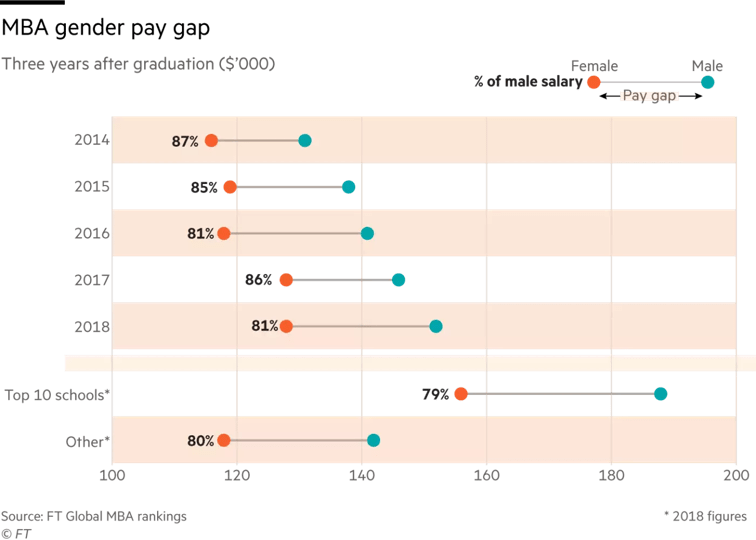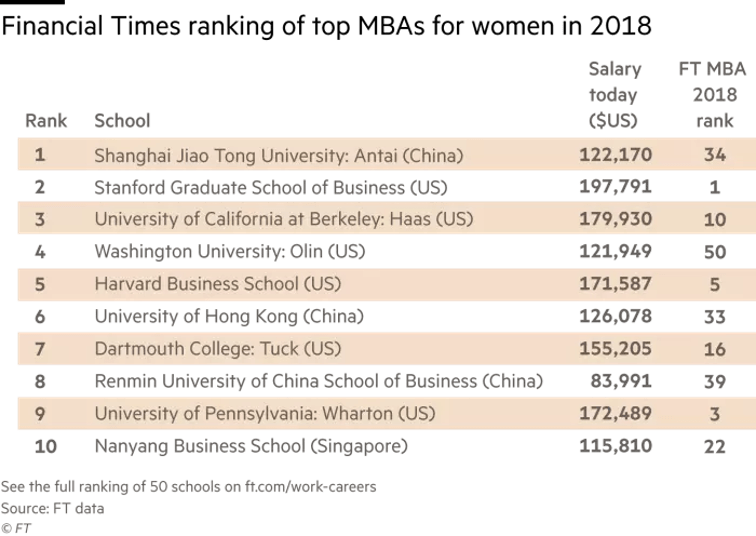For years, there’s been a growing push for women to enter business and business school, and some change has occurred. In 2017, four in 10 applicants to two-year, full-time MBA programs were women, up from 33 percent in 2013 according to the Graduate Management Admissions Council. Unfortunately, that increase in applications has not been reflected within MBA cohorts. Women still only account for a third of the students accepted into the top 100 MBA programs, the same as it was five years ago.
And there’s another issue as well: cost. Women, on average, earn around 91 percent of their male counterparts. After completion of the degree, that disparity gets even worse, with women MBAs receiving only 86 percent of their male MBA peers, according to Financial Times data. This income disparity can make it even harder for women to justify the high cost of an MBA, which has an average opportunity cost of $103,000 combined with an average tuition cost of $100,000. Those who do take the plunge despite earning a smaller salary pre- and post-graduation need to be assured the best possible return on their investment.
It’s for precisely these reasons that the Financial Times decided to create a new Global MBA ranking specifically for women. The FT Top MBAs for Women Ranking 2018, published earlier this week, reviews MBA programs based on which are most beneficial to women in terms of ensuring that their investment will pay off. It examines aspects ranging from how an MBA program helps its female graduates overcome pay discrimination to which schools are best at teaching and developing their female MBA students. This new ranking only looks at a school’s outcome for women—not for men—resulting in a top-10 list that differs markedly from the FT‘s own Global MBA ranking, published in January.
That’s because the FT‘s Global MBA ranking doesn’t measure whether women do as well as their male counterparts upon graduation. This new ranking takes a harder look at business schools specifically in term of their outcomes for women. This approach allowed the FT to identify both the schools where women perform best and the schools where the disparity between men and women’s success is greatest.
Top MBAs for Women
Some schools—such as Stanford Graduate School of Business, UC Berkeley’s Haas School of Business, Harvard Business School, and the University of Pennsylvania’s Wharton School—also ranked in the top 10 of the Global MBA ranking. But several of the other schools in this women’s ranking shot to the top 10 from places they held much further down the list when the success of all of their graduates was considered.
Notably, four Chinese schools appear in the top 10 for women—including the number-one ranked Shanghai Jiao Tong University: Antai—but all were just mid-range in the FT Global MBA ranking. What gives? What are these Chinese schools doing differently that works so well for women?
According to the FT analysis that accompanied this new ranking, Chinese women are given greater opportunity in the workplace. “We provide flexibility to our students on a case-by-case basis,” Mantian Wang, director of Antai’s International MBA program, told the FT. So even though Chinese society encourages women to start a family at an early age, the Chinese workplace also provides greater flexibility to working moms to balance both motherhood and a career. “But we also have a tradition of grandparents helping out a lot with the family,” Wang added.
Ranking Methodology
The ranking also reveals which MBA programs have the most significant impact on alumna salaries. The methodology looks at the absolute salary as well as the increase three years after graduation to determine which schools provide the best ROI. Female salaries were also compared to male salaries over the same three years to identify gender pay gaps. Other considerations used to arrive at the list of top MBA programs for women included gender balance among students and faculty and how female students felt the MBA helped them achieve their goals.
Overall, the ranking methodology included 11 different criteria—alumnae responses making up eight of those and accounting for 70 percent of the score. The remaining 30 percent of the score was based on data provided by participating schools, much of it the same data previously collected for the Global MBA ranking, including career and salary progression. But here again, for the purposes of this new ranking, only data for female students was considered. To be eligible to participate in the rankings, the schools had to have a minimum number of female respondents, which is how 58 schools ended up as participants.
To learn more about the methodology and to get an in-depth look at the Top MBAs for Women, visit the Financial Times website.







